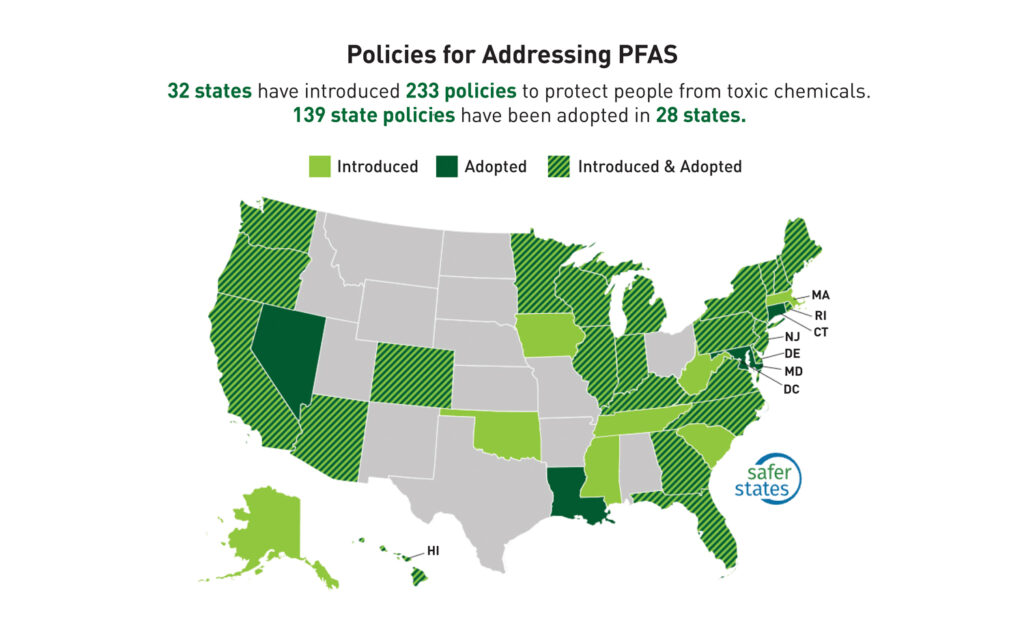
Per- and polyfluoroalkyl substances (PFAS) are a group of several thousand fluorinated organic compounds. Because of their unique physical and chemical properties, PFAS have been widely used in everything from consumer products such as textiles to industrial applications such as firefighting foams.
Scientific evidence demonstrates that PFAS are “forever chemicals” that bioaccumulate and are linked to adverse effects on human health and the environment. As a result, U.S. federal and state agencies have started publishing stringent regulatory and guidance values for PFAS in water, soil and air. Consequently, there has been a dramatic rise in media attention and PFAS litigation. Companies wishing to mitigate this surge in legal challenges require proactive measures and considerations as the tides continue to change.
Inconsistent PFAS regulatory standards
In recent years, federal, state and international authorities have established various health-based regulatory values and evaluation criteria for certain specific PFAS in response to growing concerns. At this time, there are no final federally enforceable PFAS standards, leaving individual states to navigate approaches for addressing PFAS contamination. Some states have established legally enforceable values for certain PFAS in environmental media. Other states have opted for non-enforceable standards such as advisories, guidance documents or screening levels. As a whole, there is no uniformity in PFAS standards across the different jurisdictions—further adding to the frustration and confusion of stakeholders.
Legislative trends targeting textiles and consumer products
Several states have proposed PFAS legislation that adversely affects the textile industry. These initiatives can be grouped into three primary categories:
- Banning or restricting the use, sale and distribution of PFAS-containing products
- Requiring disclosure of intentionally added PFAS
- Mandating that state agencies further study the effects of PFAS
Notably, the state of Maine was the first government in the world to ban the sale of any products containing intentionally added PFAS. The new law is effective Jan. 1, 2030, with limited exceptions. Other states, including California, New York and Washington, have proposed legislation that prohibits the sale and distribution of textile articles containing PFAS or total organic fluorine. These legislative trends targeting textiles will likely continue.

PFAS litigation trends
1. Government litigation activity
For those who have seen the movie Dark Waters, you may recall that the crisis arising from the use of PFAS arose from a determination that these “forever chemicals” are found in groundwater and linked to negative human health effects. The movie focuses on the actions of DuPont and the chemical companies that manufacture PFAS chemicals. But the risk of litigation from PFAS chemical use extends beyond the companies that made these products.
Most of the PFAS lawsuits to date have been filed by state and local government entities focusing on drinking water contamination and cleanup. Damages sought often include the costs for sophisticated, expensive water filtration systems designed to remove PFAS from groundwater and drinking water. Settlements from the initial wave of PFAS litigation amount to billions of dollars.
Increasingly, the targeted defendants include more than the chemical manufacturers. Companies that used PFAS in their products, such as repellents, are also being named in lawsuits. The expansion of this litigation is exemplified in recent lawsuits in Alabama and Georgia naming carpet manufacturers as parties responsible for PFAS pollution. Carpet manufacturers typically used PFAS to add stain resistance, and the permitted wastewater from their processes was directed to water utilities. Downstream municipalities, like the city of Rome, Ga., later sued the carpet manufacturers as well as the chemical companies to recover the remediation and filtration costs related to the PFAS contamination. These cases present implications for textile companies that have applied PFAS-containing repellents to their products.
2. Personal injury actions
The “other shoe” yet to drop in any meaningful way is the growth of personal injury actions against the manufacturers and users of PFAS. At this time, the scientific support to causally link PFAS exposure to cancer or serious illnesses is not fully developed. Consequently, PFAS personal injury litigation has limitations. However, the litigation risks to product manufacturers that use PFAS remain as science further examines the human health effects of PFAS and causal links improve.
The potential scope of yet unrealized risk is similar to asbestos litigation. Historically, asbestos, like PFAS chemicals, was used in a variety of applications and manufacturing processes. It was not until years after the widespread use of asbestos that science established that excessive exposure to asbestos was a causative agent for cancer, particularly mesothelioma. Initially the targeted defendants in asbestos lawsuits included companies that mined, processed and sold asbestos. Over time, however, liability was extended to companies that used asbestos in their products. Such is the potential risk of PFAS litigation. If medical researchers establish a stronger link between PFAS exposure and disease, personal injury lawsuits will proliferate. As a result, any business, including textiles, that uses PFAS in its products can expect to be caught in the mass tort litigation storm.
Strategies to mitigate PFAS legal risks
Although there is no fail-safe way to eliminate legal risks associated with these trends, companies should consider these potential strategic approaches for mitigation:
- Monitor state and federal PFAS legislation and regulations
- Identify timelines for compliance with PFAS requirements
- Identify operational risks related to PFAS
- Require disclosures for PFAS suppliers and vendors
- Review insurance policies for coverage of PFAS liabilities and claims
- Conduct due diligence of PFAS in commercial and real estate transactions
This list is not meant to be exhaustive. Companies should consult with legal counsel regarding the legal implications of using PFAS.
Daniella Landers and Michael Sullivan are partners at the law firm Womble Bond Dickinson LLP. They can be reached at womblebonddickinson.com.
SIDEBAR: Preparing for possible litigation
Businesses looking to prepare for potential PFAS litigation and mitigate other related liabilities should attempt to locate all the insurance policies purchased from as far back as their first use of any PFAS chemicals in their products. Some of the alleged liability for pollution or misuse of PFAS may arise from use in the 1990s (or before), and uncovering insurance policies from that far back will require concerted investigation and effort. This is particularly true if those liabilities arise from business subsidiaries and divisions that were acquired years later. Nevertheless, a detailed chronology of all business insurance coverage from the earliest use of PFAS may provide important financial protection.
Sidebar: California PFAS legislation
On Sept. 29, 2022, California Governor Gavin Newsom signed into law a bill banning per- and polyfluoroalkyl substances (PFAS) in textiles. Assembly Bill (AB) No. 1817 prohibits the manufacture, distribution or sale within the state of any new textile articles containing PFAS beginning Jan. 1, 2025. As defined in AB 1817, “textile articles” are textile goods customarily or ordinarily used in households and businesses, such as apparel, accessories, handbags, backpacks, draperies, shower curtains, furnishings, upholstery, beddings, towels, napkins and tablecloths. AB 1817 specifies that the ban does not apply to “outdoor apparel for severe wet conditions,” including personal protective equipment (PPE) such as firefighter gear, until Jan. 1, 2028. However, starting Jan. 1, 2025, distributors or sellers of such outdoor apparel must provide a disclosure with the statement “Made with PFAS chemicals.”
 TEXTILES.ORG
TEXTILES.ORG


